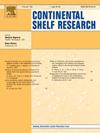Temporal and spatial distribution of Fe(II) and dissolved iron and their influencing factors in the Yangtze River estuary
IF 2.2
3区 地球科学
Q2 OCEANOGRAPHY
引用次数: 0
Abstract
Iron (Fe) is an essential trace element for the growth and metabolism of marine plankton. Fe(II), the reduced form of iron, is highly soluble and more labile in seawater, contributing significantly to iron bioavailability in marine environments. This study investigates the temporal and spatial distributions of Fe(II) and dissolved iron (DFe) during autumn (October 11–22, 2018), spring (March 4–14, 2019), and summer (July 9–17, 2019) in the Yangtze River estuary. Fe(II) concentrations decreased from nearshore to offshore, with higher levels predominantly in areas influenced by Yangtze River water, indicating that terrestrial input from the river is the main source of Fe(II). Seasonal variations in Fe(II) concentrations were observed, with the highest levels in summer and the lowest in autumn. Median Fe(II) concentrations in autumn, spring and summer were 0.60 nM, 0.81 nM, and 1.33 nM, respectively. DFe concentrations generally decreased from nearshore to offshore, except in summer. The concentration of DFe exhibits seasonal variations. Median DFe concentrations in autumn, spring and summer were 16.10 nM, 44.65 nM, and 22.41 nM, respectively. Both Fe(II) concentrations and Fe(II)/DFe ratios peaked in summer surface waters. Significant correlations were found between Fe(II)/DFe ratios and NH4-N/DIN or NO3-N/DIN ratios in summer.
长江口地区铁(II)和溶解铁的时空分布及其影响因素
铁(Fe)是海洋浮游生物生长和代谢所必需的微量元素。铁(II)是铁的还原态,在海水中具有高可溶性和更不稳定的特性,对海洋环境中铁的生物利用度有重要贡献。研究了长江口秋季(2018年10月11-22日)、春季(2019年3月4-14日)和夏季(2019年7月9-17日)铁(II)和溶解铁(DFe)的时空分布特征。铁(II)浓度由近岸向近海递减,较高水平主要集中在受长江水影响的地区,表明来自河流的陆地输入是铁(II)的主要来源。铁(II)浓度呈季节变化,夏季最高,秋季最低。秋季、春季和夏季Fe(II)浓度中值分别为0.60 nM、0.81 nM和1.33 nM。除夏季外,DFe浓度总体上由近岸向近海递减。DFe浓度呈现季节变化。秋季、春季和夏季DFe浓度中位数分别为16.10 nM、44.65 nM和22.41 nM。夏季地表水Fe(II)浓度和Fe(II)/DFe比值均达到峰值。夏季Fe(II)/DFe与NH4-N/DIN和NO3-N/DIN呈显著相关。
本文章由计算机程序翻译,如有差异,请以英文原文为准。
求助全文
约1分钟内获得全文
求助全文
来源期刊

Continental Shelf Research
地学-海洋学
CiteScore
4.30
自引率
4.30%
发文量
136
审稿时长
6.1 months
期刊介绍:
Continental Shelf Research publishes articles dealing with the biological, chemical, geological and physical oceanography of the shallow marine environment, from coastal and estuarine waters out to the shelf break. The continental shelf is a critical environment within the land-ocean continuum, and many processes, functions and problems in the continental shelf are driven by terrestrial inputs transported through the rivers and estuaries to the coastal and continental shelf areas. Manuscripts that deal with these topics must make a clear link to the continental shelf. Examples of research areas include:
Physical sedimentology and geomorphology
Geochemistry of the coastal ocean (inorganic and organic)
Marine environment and anthropogenic effects
Interaction of physical dynamics with natural and manmade shoreline features
Benthic, phytoplankton and zooplankton ecology
Coastal water and sediment quality, and ecosystem health
Benthic-pelagic coupling (physical and biogeochemical)
Interactions between physical dynamics (waves, currents, mixing, etc.) and biogeochemical cycles
Estuarine, coastal and shelf sea modelling and process studies.
 求助内容:
求助内容: 应助结果提醒方式:
应助结果提醒方式:


